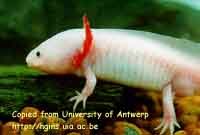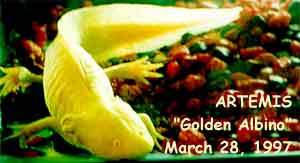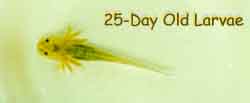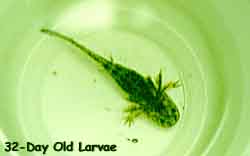index[Calixto][Description] [Axolotl FAQ]  [My Axolotls] [Habitat] [Feeding] [Health] [References] [Links] [Genetics] contactaxolotls@yahoo.com-or- Sign The Guestbook version98.12.02visitstravelDa Homepagelegal© 1996-1998Chris Eng All Rights Reserved 
|
MutantsAs of 1990, there have been 44 mutant genes identified, affecting stages of development from oogenesis to pigmentation.Colorful AxolotlsFor the keeper who is keeping an axolotl as a pet, as opposed to laboratory research, the different colors of the axolotl or its phenotype is usually of core interest.PhenotypesAlbino - Deficient pigmentation in the skin. Animal lacks melanosphoresMelanic - Extra or excess black pigmentation in the skin Xanthic - Yellow pigmentation caused by hydrolysis of guanine. ChromatosphoresIridosphores - Produces shiny iridescenceMelanosphores - Produces the dark pigment Xanthophores - Produces the yellow pigment. Example - Expressing the Albino PhenotypeThe nomenclature used by the Axolotl Colony is as follows:a - The albino gene was present in previous generations a+ - The albino gene is not present in the animal. +/a - Recessive for the albino gene. The animal has the gene but does not display it. a/a - Homozygous for the albino gene and phenotypically displays albinism. Homozygous Traitsa/a - This axolotl lacks melanosphores dark pigmentsm/m - This axolotl lacks iridosphores shiny pigments and has extra melanosphores dark pigments ax/ax - This axolotl lacks xanthophores yellow pigments and iridosphores shiny pigments Developmental Mutants - The D systemEach axolotl is either one of these three typesD/D - The color of the typical wild-type axolotl D/d - Also, the wild-type axolotl d/d - Produces the white axolotl. D/- is also synonymous with D/D (All Dark) D MutantThe 'D' stands for dark and contains all the coloring in the animal (dark, yellow, and reflective). The 'd' is a developmental mutant gene and not a pigment gene. A d/d animal develops all the normal pigment genes. However, they never migrate off the neural crest of the animal.Colorless AxolotlIf the animal is homozygous for the albino gene then the D/D and D/d animal will be golden albinos and the d/d animal will be a white albino. A d/d ax/ax m+ animal would be an absolutely colorless albinoFrankensteinolotlThe albino axolotl was first developed in 1964, by back-crossing the F2 children of a hybrid Ambystoma tigrinum (female albino tiger salamander) and an Ambystoma mexicanum (male white axolotl). If you have an albino axolotl, you can trace its ancestry back to this amazing experiment.ArtemisArtemis is a male golden albino axolotl. Phenotypically speaking he can either be a D/d a/a or a D/D a/a. The other D and A combination being d/d a/a would result in a white albino axolotl. At this point, we are not sure whether he is recessive for m or ax. After close examination of Artemis' and Calixto's offspring, we will be able to know whether Artemis is recessive for the m gene.CalixtoCalixto is a female wild-type axolotl. She is from Group 9377 that has not produced any albino axolotls in the past three generations. Therefore, it is pretty safe to assume she is a+. Her records describe her as D/ +/m ax. One of her parents is +/ax, and it is not known whether she carries it or if she is ax+. Notice the dark and yellow pigments on her body, which is an example of a non-albino D/D or D/d animal.BubbaBubba is D/ +/m +/a. Bubba is the largest of all of the first spawn. The growth rate is tremendous and his length and girth are about double the rest of his brothers and sisters. Bubba lives with his sibling, who is yet to be named.Spawn Phenotype PossibilitiesWhen the larvae reach a few weeks old, it will be possible to identify most of the genes that Artemis and Calixto do or do not carry and whether they are recessive, dominant (homozygous) or absent. If any of the offspring are white axolotls d/d, then we will know for a fact that Artemis and Calixto are both D/d.Missing PiecesWe can eventually determine, from this first spawn, whether Artemis and Calixto are D/d or D/D or +/m or m+. Unfortunately, this first go around might not tell us whether the parents are recessive +/ax for the axanthic gene.Extrapolating Recessive GenesApril Fool's '97 - All of the remaining larvae have gold-rings around their eyes, and therefore I have concluded that Artemis is D/ a/a m+. Since all of the larvae are wild-type D/D or D/d, I believe Artemis is either D/D a/a m+ +/ax; D/d a/a m+ +/ax; D/D a/a m+ ax+; or D/d a/a m+ ax+ and Calixto is either D/D a+ +/m ax+; D/d a+ +/m ax+; D/D a+ +/m +/ax; or D/d a+ +/m +/ax. Out of the statistical 16 combinations between Artemis and Calixto, it can be taken down to only 9 possible combinations. This is because both animals cannot both be recessive for the ax, m, a, or D genes.Blue Spotted Axolotls?Some Adults with the London lethal gene L have a bluish-gray, blotched or spotted pattern.Further ExperimentsI will be keeping, or will have access to at a least a pair of the offspring from the first spawn in the coming year. I will mate them in 1998, and finish this section. Basically, what I hope to do is determine the presence or absence of the axanthic gene, and also to determine if Artemis or Calixto carry the developmental mutant 'd'F2'sIf I mate two axolotls from my first spawn we can expect 45% will be wild-types, 20% will be dark, 20% will be golden, and 5% will be yellow. Yellow axolotls look like golden albinos with the exception of the iridiscence.Artemis and SpawnIf I mate Artemis with one of his offspring, statistically speaking, since we do not know yet whether Calixto or Artemis carry the 'd' or 'ax' gene, the odds of the offspring being homozygous for any of any the phenotypical genes are as follow:50% - Albino, 4% White, 4% Axanthic, and 0% Melano. Further broken down, the odds say that 2% would be white albinos and 48% would be golden albinos. Even if the developmental gene 'd' is not present in Calixto or Artemis, I would at least be guaranteed golden albinos in that pairing. Calixto and SpawnIf I mate Calixto with one of her offspring we would not get any albinos at all. They would be 100% wild-types (Calixto). There would be a 50% chance that 50% of the offspring would be dark and 50% wild-type depending whether the offspring is recessive or absent the m gene.ReferencesBorland, Sandra. Personal Communication 1996-7.IU Axolotl Colony. Overview of Axolotl Genetics and Nomenclature 1996. Scott, Peter. Axolotls. TFH Publications 1995. |
    
|